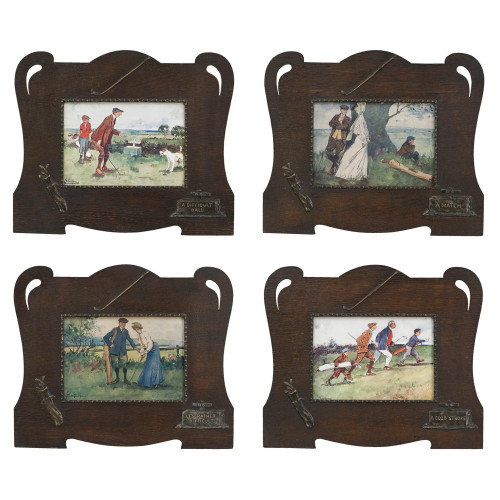- Home
- Golf
- Artwork, Paintings & Prints
- Life Association Golf Print 1912 Calender St Andrews, High Hole
Life Association Golf Print 1912 Calender St Andrews, High Hole
Life Association Golf Print 1912 Calender St Andrews, High Hole
St. Andrews - High Hole.
A Life Association of Scotland 1912 calendar. The calendar is with a wonderful golfing picture of St. Andrews. The picture is applied to the board and is taken from the painting by Michael Brown. The title is 'St. Andrews - High Hole. (Coming Home)'. It features Mr. Guy Campbell, Mr. L.M. Balfour-Melville, Mr. J.L. Low and Mr. Edward Blackwell.
The Life Association of Scotland was established in 1838 in Edinburgh. In the late 1800's golf courses were being established all over Scotland and the financial community set up the Insurance & Banking Golf Club on the Duddingston estate in 1895, beneath the spectacular backdrop of the extinct volcano, Arthur's Seat. To mark the opening of the extended Club House, Michael Brown was commissioned to paint a scene from an exhibition golf match at the Club. The 1899 Life Association of Scotland calendar used this image as its center piece. It was such a marketing success Brown was then commissioned to annually paint a golfing picture until 1916, prints were made of these originals and glued to the cardboard calendar that the Life Association of Scotland produced. Brown's original paintings adorned the walls of the Edinburgh head office for many years.
St Andrews "The Home of Golf" is on the Fife Coast of eastern Scotland and is considered the oldest and most iconic golf course in the world. The Old Course is 6721 yards with a par of 72. It is famous for the 'Swilcan Bridge' spanning the first and 18th holes and 'Hell Bunker'. Everyone who plays the 18th hole walks over the 700-year-old bridge, with it featuring in many iconic pictures of St Andrews. The Old Course remains a public golf course, open to all and apart from the clubhouse for the Royal and Ancient, there are clubhouses overlooking the links for The St Andrews Golf Club (1843) and The New Golf Club St Andrews (1902) for men and the St Rule Club (1896) and St Regulus Ladies Golf Club (1913) for women.
The Old Course was pivotal to the development of golf and how the game is played today. By 1754, St Andrews consisted of twelve holes, ten of which were played twice, making a round of twenty-two holes in all. The members deciding that the first four and last four holes on the course were too short combined them into four holes (two in and two out). St Andrews then became the first 18-hole golf course in the world, and a blue print for the modern course.
In 1863 the R&A appointed 'Old' Tom Morris as Custodian of the Links and with the skills he had learnt at his time in Prestwick, he went about rejuvenating St Andrews. He established separate tee boxes on each hole, the fairways were widened, the greens enlarged and two new ones were constructed. The hazards were actively managed (before then hazards and bunkers had been left to mother nature) all of this spread out play over larger areas, thus increasing the volume of golf being played at St Andrews. Tom introduced the concept of top-dressing greens with sand, was the first to use a push mower to cut greens and all the time this was helping to improve the quality of the course. He also owned a shop and workshop at 8 The Links, which still exists.
Dimensions:
1912
Untied Kingdom
Original and very good
Thank you for your enquiry.
We will get back to you soon.
Please create wishlist to add this item to
RELATED ITEMS
























